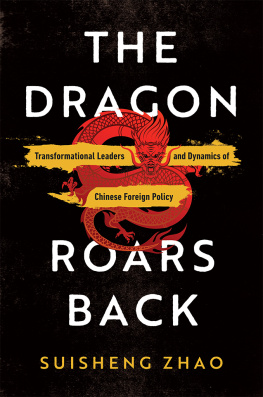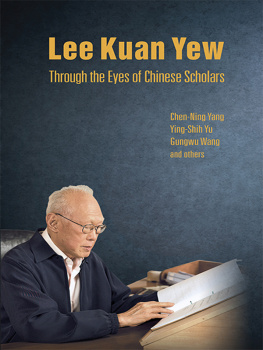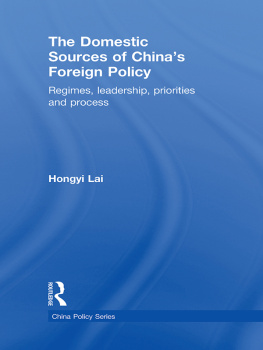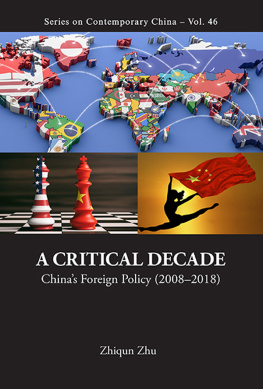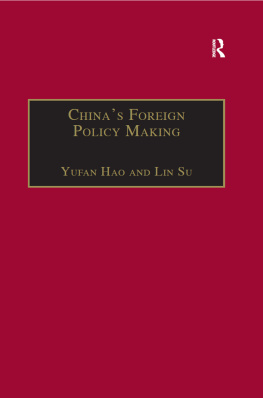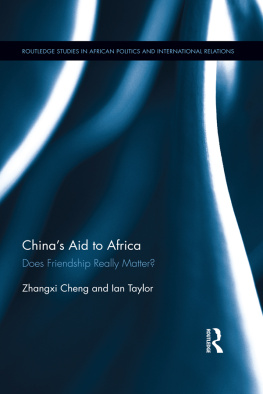The Dynamics of Foreign-Policy Decisionmaking in China
First published 2000 by Westview Press
Published 2018 by Routledge
711 Third Avenue, New York, NY 10017, USA
2 Park Square, Milton Park, Abingdon, Oxon OX14 4RN
Routledge is an imprint of the Taylor & Francis Group, an informa business
Copyright 2000 by Lu Ning
All rights reserved. No part of this book may be reprinted or reproduced or utilised in any form or by any electronic, mechanical, or other means, now known or hereafter invented, including photocopying and recording, or in any information storage or retrieval system, without permission in writing from the publishers.
Notice:
Product or corporate names may be trademarks or registered trademarks, and are used only for identification and explanation without intent to infringe.
Library of Congress Cataloging-in-Publication Data
Lu, Ning, 1995-
The dynamics of foreign-policy decisionmaking in China / Lu Ning.2nd ed.
p. cm.
Includes bibliographical references and index.
ISBN 0-8133-3746-1
1. ChinaForeign relations administration. 2. ChinaForeign relations1949.
I. Title.
JZ1730.L8 2000
327.5dc21
99-058483
ISBN 13: 978-0-8133-3746-3 (pbk)
To my parents
Lu Yujin and Xu Mingbao
| CASS | Chinese Academy of Social Sciences |
| CIISS | China Institute of International and Strategic Studies |
| CMC | Central Military Commission |
| COSTIND | Commission of Science, Technology, and Industry for National Defense |
| CPAFFC | Chinese Peoples Association for Friendship with Foreign Countries |
| CPC | Communist Party of China |
| CPIFA | Chinese Peoples Institute of Foreign Affairs |
| FAO | Foreign Affairs Office |
| GED | General Equipment Department |
| GPD | General Political Department |
| GSD | General Staff Department |
| HMAO | Hong Kong and Macau Affairs Office of the State Council |
| ICIR | Institute for Contemporary International Relations |
| IIS | Institute of International Studies |
| ILD | International Liaison Department |
| LSG | leading small group |
| MFA | Ministry of Foreign Affairs |
| MOFTEC | Ministry of Foreign Trade and Economic Cooperation |
| NORINCO | North Industrial Corporation |
| OCAO | Overseas Chinese Affairs Office of the State Council |
| PFLI | Peking Foreign Language Institute |
| PLA | Peoples Liberation Army |
| PLAN | PLA Navy |
| PRC | Peoples Republic of China |
| RFI | request for instructions |
| SALT I | Strategic Arms Limitation Treaty |
| TAO | Taiwan Affairs Office of the State Council |
| TFA | Third Field Army |
I would like to thank the United States Institute of Peace for providing a generous grant, which made researching and writing this book possible. In particular, I am grateful to Dr. Richard H. Solomon, President of the Institute of Peace, and Professor W. Scott Thompson for helping to organize a special session to discuss the manuscript. I would also like to thank Dr. Alfred D. Wilhelm Jr., Executive Vice President of the Atlantic Council of the United States, for hosting me while I was researching and writing the book; Karen Sutter, for reading through and commenting on my manuscript; and Dana Liu, for administrative assistance. Thanks also go to Hua Di, who provided details on a case study I have used for the book. I am deeply indebted to the late A. Doak Barnett, without whose strong support and encouragement, as well as assistance, I probably would never have submitted my research findings for publication.
Lu Ning
The end of the Cold War has dramatically shifted the focus of international relations to trade and economy. Nowhere is the quest for economic growth pursued with such single-mindedness than in the Asia-Pacific region where its success is rapidly transforming this vast and diverse region from Ulan Bator to Jakarta, from Urumchi to Tokyo. Increasingly countries in the region view their national security in terms of sustained economic growth. By the mid-1990s, the economies of the Asia-Pacific region (excluding the United States and Canada) accounted for 34 percent of world output. Their share is expected to reach more than 40 percent. Trade between the United States and the Asia-Pacific region was 40 percent larger than U.S.-West European trade.
The most noticeable trend is the recent rise of China. In the two decades since China embarked on a course of economic reform, Chinas real gross national product has registered an average growth rate of more than 9 percent a year. Measured in terms of purchasing power, Chinas economy by the mid-1990s ranked third, behind only those of the United States and Japan.
The implications of this transformation for the rest of the world have not been fully assessed. Already we are witnessing some of its impact on international relations:
- Chinas continued trade in missile and nuclear technologies is causing serious tensions between China and the United States, which in the past imposed sanctions against the former;
- Chinas military modernization programits postCold War arms purchases and the shift in its military doctrine to fighting local warsand its continuing territorial disputes in the South China Sea have caused anxieties among its Southeast Asian neighbors;
- Chinas growing trade surplus with the United States and Western Europe has become a major point of friction between China and those countries;
- Partly because of the dynamic growth in China, East and Southeast Asian economies, which in the past had been dependent on the markets in industrialized countries and thus vulnerable to their economic downturns, were able to maintain their economic growth through the last economic recession in the West. The growing economic integration of South China, Hong Kong, and Taiwan may soon emerge as a new engine of growth for the region;
- Chinas high economic growth rate is outstripping the growth of its domestic energy supply. Since the second half of 1993, China has, perhaps irreversibly, become a net oil importer. Most of its future oil imports will have to come from the Middle East, particularly the Gulf region, via the South China Sea.
If the current trends continue, China will become a much more significant player in world affairs in a decade. However, as its economy is rapidly being integrated into the world economy, China maintains a communist system of political control by a single party. Under this political system, major decisions, particularly political and foreign-policy decisions, are made with little transparency. This is in sharp contrast to the significant impact these decisions are likely to have on the rest of the world and is likely to produce great uncertainties that may have serious implications for future international relations and maintenance of world peace.
In the meantime, foreign-policy decisionmaking in China is undergoing a period of transition. In the early years of the Peoples Republic of China, Mao Zedong allowed a limited degree of top leadership participation in some of the key foreign-policy discussions and debates, as in the early decision to enter into strategic alliance with the Soviet Union, known as leaning to one side in the new regimes foreign-policy orientation, and most importantly in the decision to intervene in the Korean conflict in 1950.




